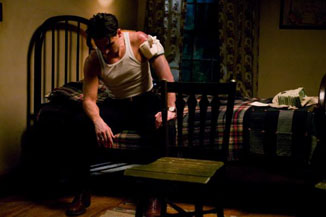He Said, She Said: Public Enemies
By Caroline Thibodeaux
July 7, 2009
She said...
Last week the Big Daddy and I watched the new Michael Mann movie Public Enemies, starring Johnny Depp as bank robber John Dillinger. Set in 1933, the story covers the last year or so in the life and career of this uniquely American combination of folk anti-hero and sociopath. The screenplay is adapted by Mann with Ronan Bennett and Ann Biderman from Bryan Burrough's non-fiction book Public Enemies: America's Greatest Crime Wave and the Birth of the FBI, 1933–34. It examines how Dillinger and his contemporaries Pretty Boy Floyd and Baby Face Nelson were literally mowed down on the way to their own obsolescence. As the reigning Public Enemy Number One, Dillinger's journey is a distinct parallel opposite to the rise of the Federal Bureau of Investigation as that organization begins to apply the scientific method to modern crime-fighting techniques. Everything signifies and forecasts Dillinger's end – including the ways that big time crime operations were beginning to evolve. The day of the dashing, celebrated bank robber escaping with a bag of loot while dazzling the pretty girls he takes hostage was quickly disappearing and going the way of the relic.
This film has an awful lot going for it. It's a gangster movie with a remarkable pedigree. Michael Mann is one of those directors who I can always appreciate even when I'm not particularly fond of his films (Ali, Miami Vice). I truly enjoyed all of the meticulous detail and craftsmanship involved in Public Enemies. Shot in gorgeous hi-definition digital, it's a beautiful film to behold. But in the end there was something missing in terms of dramatic tension. It has a leisurely pace and it takes its time setting up the action. This drama is definitely a welcome change in a summer movie season filled with the umpteenth sequels to robots, terminators and comic book hero flicks. But I kept waiting for a moment where the film would kick into a third or fourth gear and never look back upon the arc of its own exhilaration. I admit this may be a fault of my own expectations, but whenever the tempo seemed to really get moving, Mann would bring the film back to a more sedate and contemplative state. It's an opportunity for Dillinger to look back on his life and plan his next move, I guess, but it also seems like a squandered opportunity for Mann to bring the audience along completely.
Oscar-nominated Director of Photography Dante Spinotti - a Mann stalwart – choreographs a fascinating dance between foreground and background in every frame. He creates a dioramic effect which enables the modern audience to peer through a Depression-era multidimensional picture book of slate grays, blues and warm golds. The visual textures soak through the screen. Dressing Johnny Depp for the fifth time is two-time Oscar winner Colleen Atwood. Her stunning period costume design surpasses her usual standard of excellence. These clothes are characters – one overcoat even serving ably as a plot device. The intermittent score by Elliot Goldenthal is an anachronistic mélange informed by indigenous American music. The sumptuous soundtrack is peppered with classic Billie Holliday standards and the bluesy banjo strummings of Otis Taylor.
Continued:
1
2




